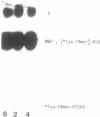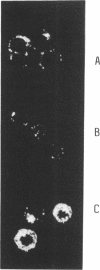Abstract
Inhibition of gene expression by antisense oligonucleotides is limited by their low ability to enter cells. Knowing that sugar binding receptors, also called membrane lectins, efficiently internalize neoglycoproteins bearing the relevant sugar, 6-phosphomannose, for instance, oligonucleotides--substituted on their 5'-end with either a fluorescent probe or a radioactive label on the one hand, and bearing a thiol function on their 3'-end, on the other hand,--were coupled onto 6-phosphomannosylated proteins via a disulfide bridge. The oligonucleotide bound to 6-phosphomannosylated serum albumin is much more efficiently internalized roughly 20 times than the free oligonucleotide. Although most of the oligonucleotides are associated with vesicular compartments, oligonucleotides after releasing from the carrier by reduction of the disulfide bridge may find their way to reach the cytosol and then lead to an increase in the efficiency of the oligonucleotides.
Full text
PDF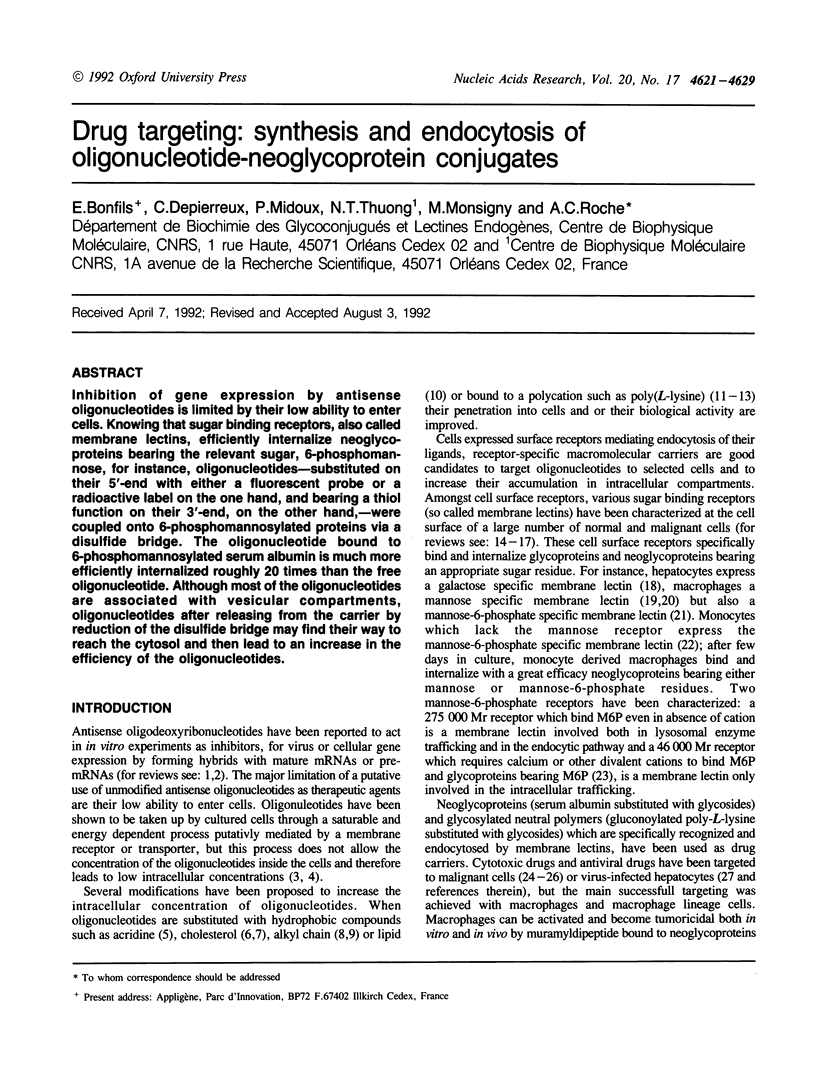
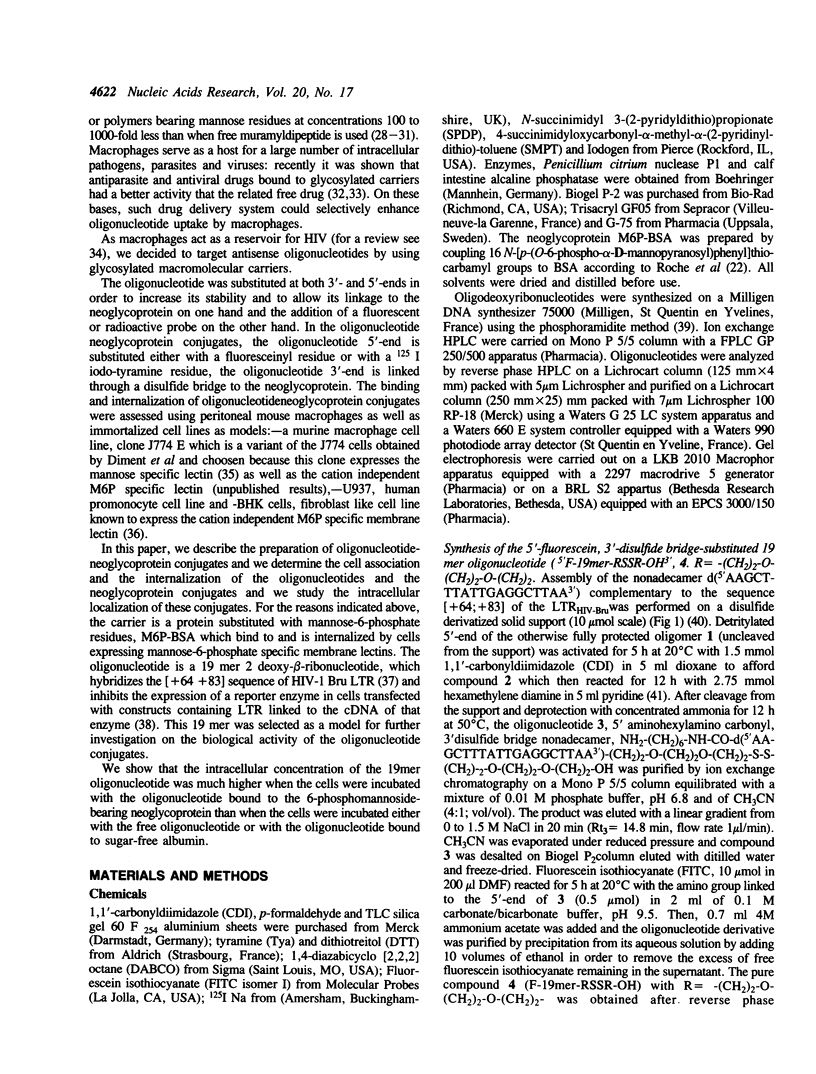
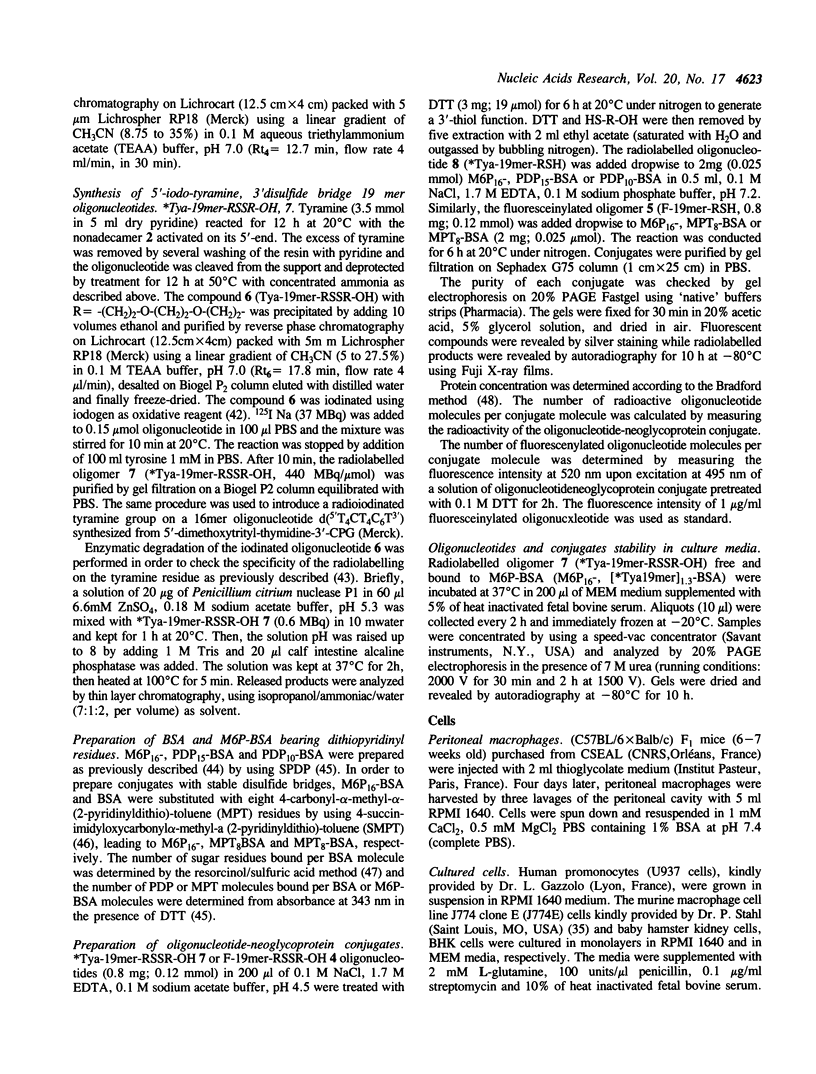
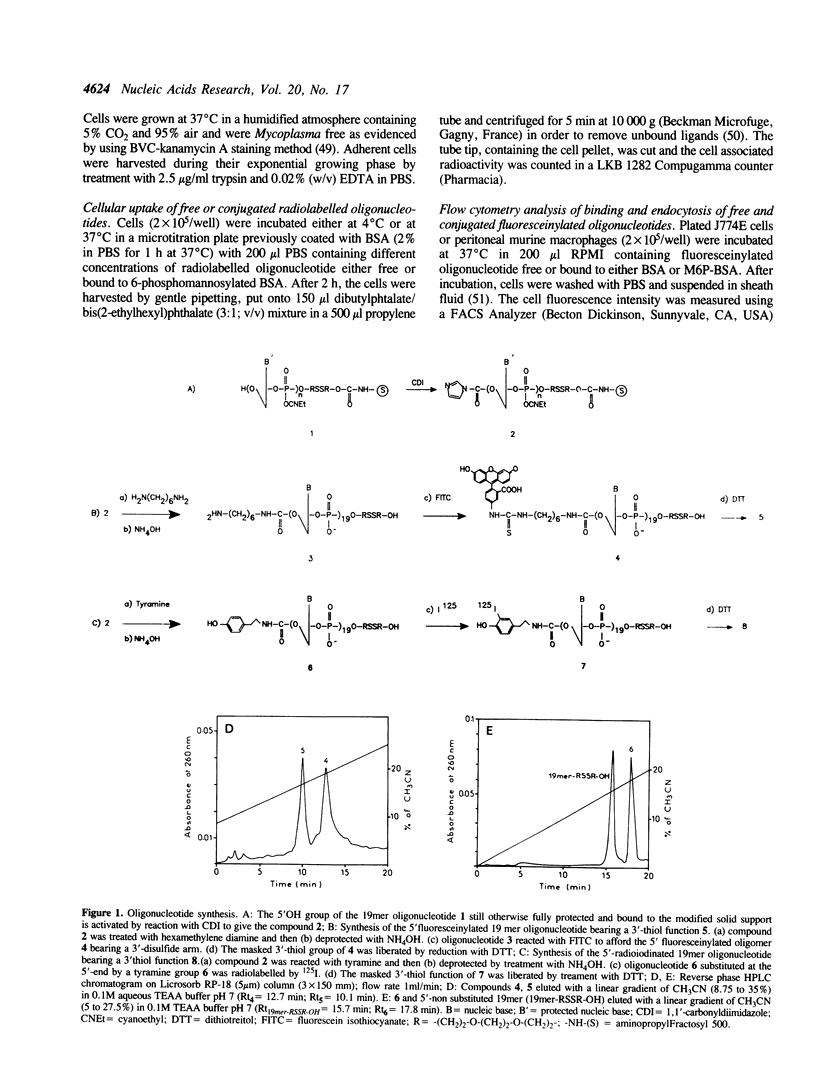
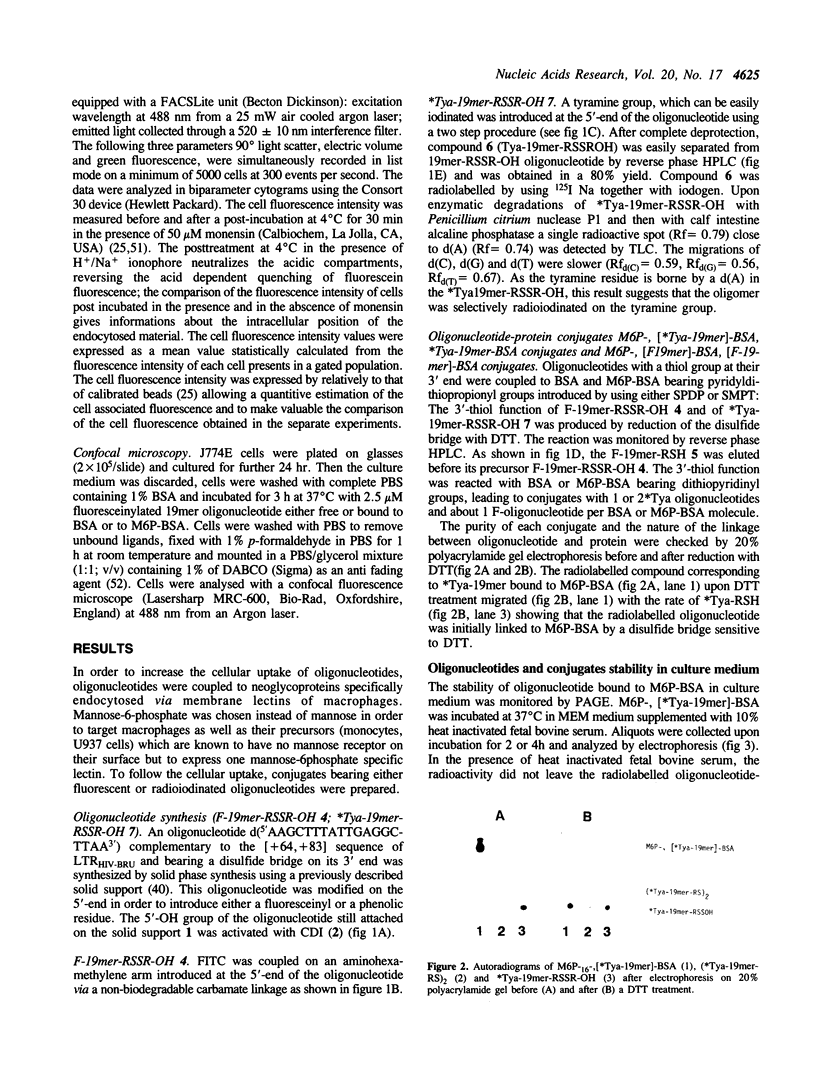
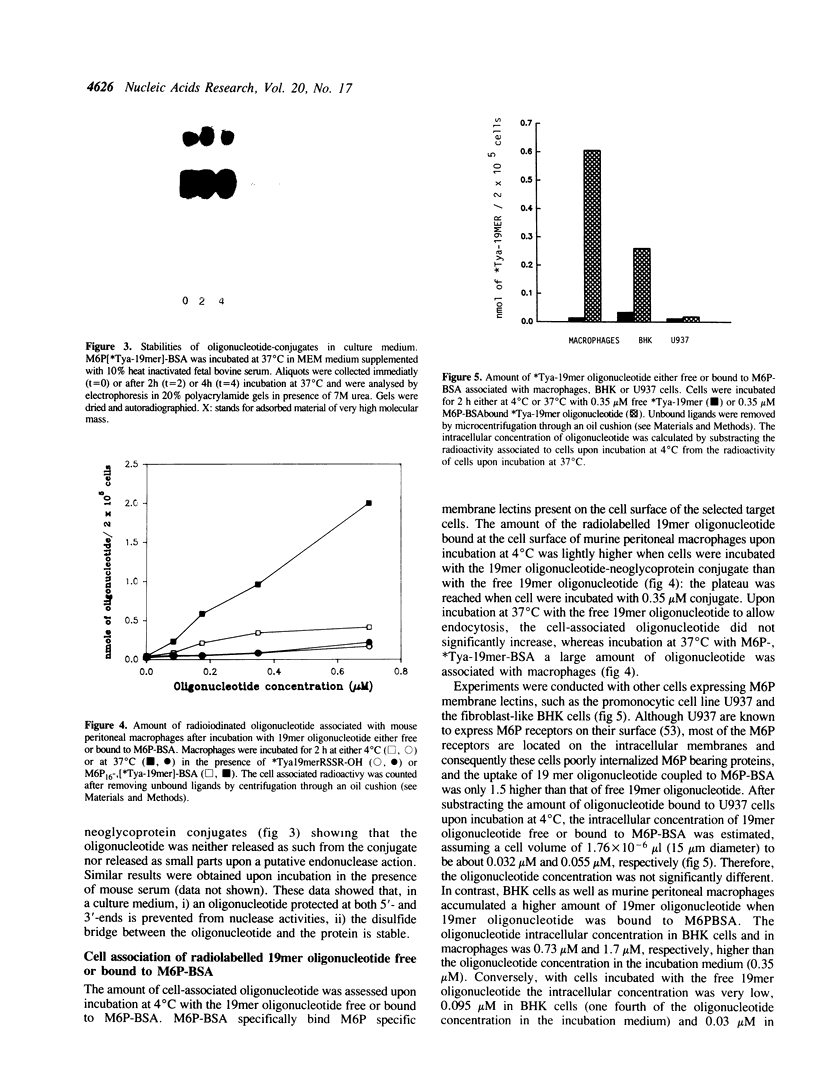
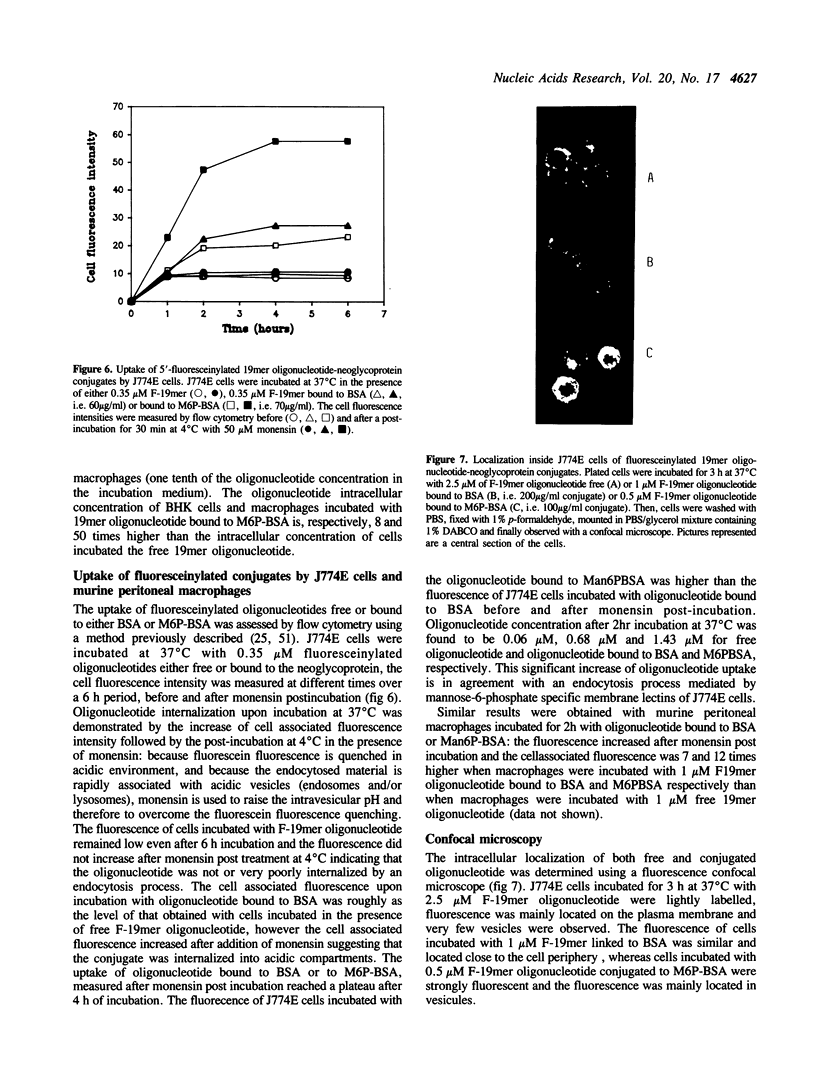
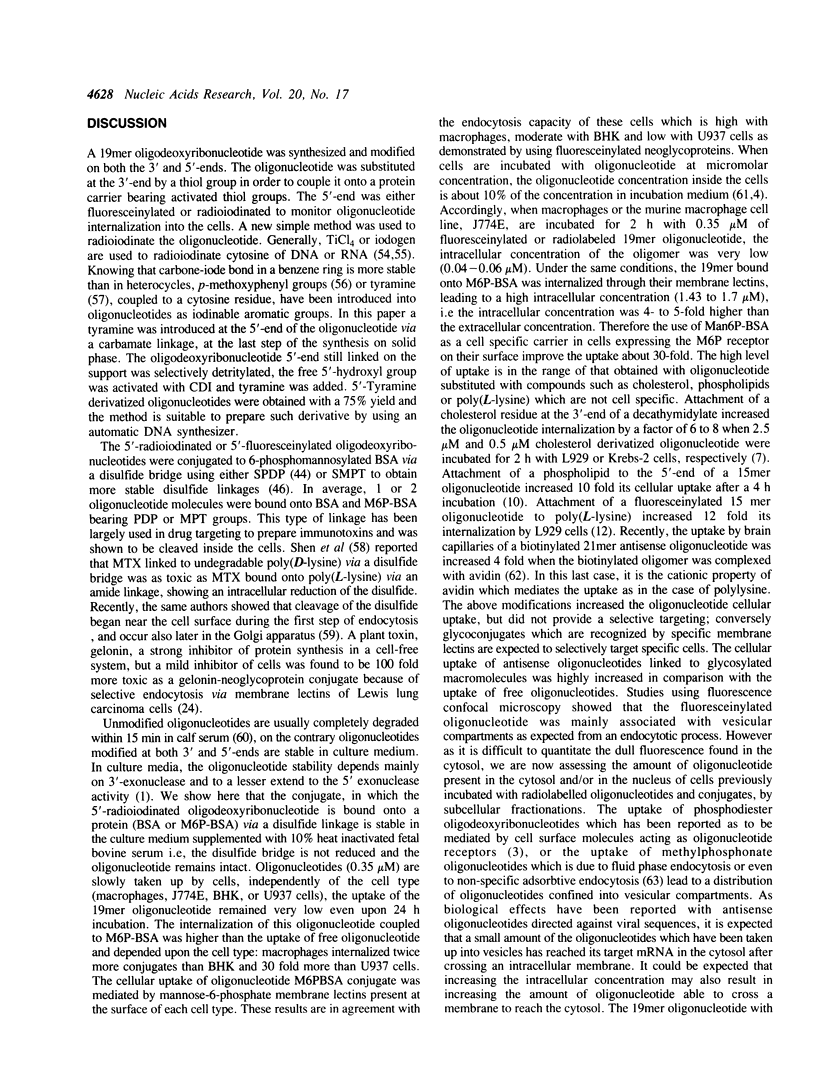
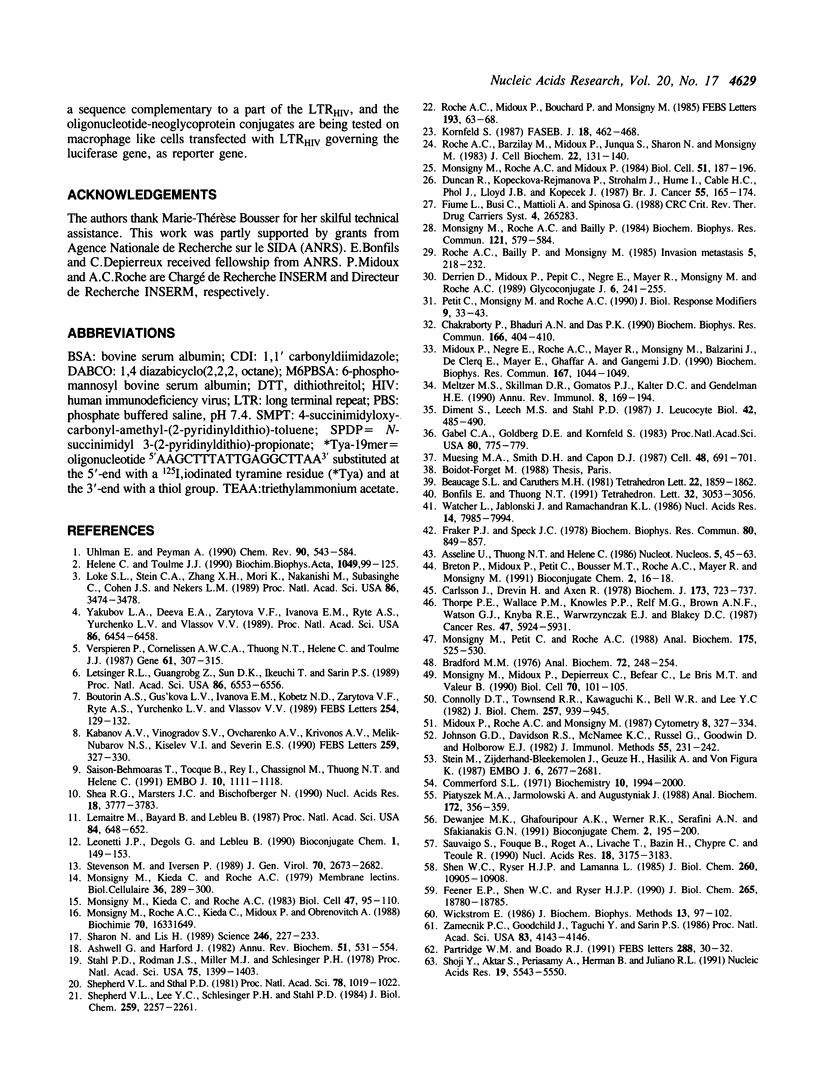
Images in this article
Selected References
These references are in PubMed. This may not be the complete list of references from this article.
- Ashwell G., Harford J. Carbohydrate-specific receptors of the liver. Annu Rev Biochem. 1982;51:531–554. doi: 10.1146/annurev.bi.51.070182.002531. [DOI] [PubMed] [Google Scholar]
- Boutorin A. S., Gus'kova L. V., Ivanova E. M., Kobetz N. D., Zarytova V. F., Ryte A. S., Yurchenko L. V., Vlassov V. V. Synthesis of alkylating oligonucleotide derivatives containing cholesterol or phenazinium residues at their 3'-terminus and their interaction with DNA within mammalian cells. FEBS Lett. 1989 Aug 28;254(1-2):129–132. doi: 10.1016/0014-5793(89)81023-3. [DOI] [PubMed] [Google Scholar]
- Bradford M. M. A rapid and sensitive method for the quantitation of microgram quantities of protein utilizing the principle of protein-dye binding. Anal Biochem. 1976 May 7;72:248–254. doi: 10.1006/abio.1976.9999. [DOI] [PubMed] [Google Scholar]
- Breton P., Midoux P., Petit C., Bousser M. T., Roche A. C., Mayer R., Monsigny M. Production of macrophage-derived cytotoxic factor by N-[3-[(carbamoylmethyl)thio]propionylated] neoglycoproteins. Bioconjug Chem. 1991 Jan-Feb;2(1):16–18. doi: 10.1021/bc00007a003. [DOI] [PubMed] [Google Scholar]
- Carlsson J., Drevin H., Axén R. Protein thiolation and reversible protein-protein conjugation. N-Succinimidyl 3-(2-pyridyldithio)propionate, a new heterobifunctional reagent. Biochem J. 1978 Sep 1;173(3):723–737. doi: 10.1042/bj1730723. [DOI] [PMC free article] [PubMed] [Google Scholar]
- Chakraborty P., Bhaduri A. N., Das P. K. Sugar receptor mediated drug delivery to macrophages in the therapy of experimental visceral leishmaniasis. Biochem Biophys Res Commun. 1990 Jan 15;166(1):404–410. doi: 10.1016/0006-291x(90)91959-v. [DOI] [PubMed] [Google Scholar]
- Commerford S. L. Iodination of nucleic acids in vitro. Biochemistry. 1971 May 25;10(11):1993–2000. doi: 10.1021/bi00787a005. [DOI] [PubMed] [Google Scholar]
- Connolly D. T., Townsend R. R., Kawaguchi K., Bell W. R., Lee Y. C. Binding and endocytosis of cluster glycosides by rabbit hepatocytes. Evidence for a short-circuit pathway that does not lead to degradation. J Biol Chem. 1982 Jan 25;257(2):939–945. [PubMed] [Google Scholar]
- Derrien D., Midoux P., Petit C., Nègre E., Mayer R., Monsigny M., Roche A. C. Muramyl dipeptide bound to poly-L-lysine substituted with mannose and gluconoyl residues as macrophage activators. Glycoconj J. 1989;6(2):241–255. doi: 10.1007/BF01050652. [DOI] [PubMed] [Google Scholar]
- Dewanjee M. K., Ghafouripour A. K., Werner R. K., Serafini A. N., Sfakianakis G. N. Development of sensitive radioiodinated anti-sense oligonucleotide probes by conjugation technique. Bioconjug Chem. 1991 Jul-Aug;2(4):195–200. doi: 10.1021/bc00010a001. [DOI] [PubMed] [Google Scholar]
- Diment S., Leech M. S., Stahl P. D. Generation of macrophage variants with 5-azacytidine: selection for mannose receptor expression. J Leukoc Biol. 1987 Nov;42(5):485–490. doi: 10.1002/jlb.42.5.485. [DOI] [PubMed] [Google Scholar]
- Duncan R., Kopecková-Rejmanová P., Strohalm J., Hume I., Cable H. C., Pohl J., Lloyd J. B., Kopecek J. Anticancer agents coupled to N-(2-hydroxypropyl)methacrylamide copolymers. I. Evaluation of daunomycin and puromycin conjugates in vitro. Br J Cancer. 1987 Feb;55(2):165–174. doi: 10.1038/bjc.1987.33. [DOI] [PMC free article] [PubMed] [Google Scholar]
- Feener E. P., Shen W. C., Ryser H. J. Cleavage of disulfide bonds in endocytosed macromolecules. A processing not associated with lysosomes or endosomes. J Biol Chem. 1990 Nov 5;265(31):18780–18785. [PubMed] [Google Scholar]
- Fraker P. J., Speck J. C., Jr Protein and cell membrane iodinations with a sparingly soluble chloroamide, 1,3,4,6-tetrachloro-3a,6a-diphrenylglycoluril. Biochem Biophys Res Commun. 1978 Feb 28;80(4):849–857. doi: 10.1016/0006-291x(78)91322-0. [DOI] [PubMed] [Google Scholar]
- Gabel C. A., Goldberg D. E., Kornfeld S. Identification and characterization of cells deficient in the mannose 6-phosphate receptor: evidence for an alternate pathway for lysosomal enzyme targeting. Proc Natl Acad Sci U S A. 1983 Feb;80(3):775–779. doi: 10.1073/pnas.80.3.775. [DOI] [PMC free article] [PubMed] [Google Scholar]
- Hélène C., Toulmé J. J. Specific regulation of gene expression by antisense, sense and antigene nucleic acids. Biochim Biophys Acta. 1990 Jun 21;1049(2):99–125. doi: 10.1016/0167-4781(90)90031-v. [DOI] [PubMed] [Google Scholar]
- Johnson G. D., Davidson R. S., McNamee K. C., Russell G., Goodwin D., Holborow E. J. Fading of immunofluorescence during microscopy: a study of the phenomenon and its remedy. J Immunol Methods. 1982 Dec 17;55(2):231–242. doi: 10.1016/0022-1759(82)90035-7. [DOI] [PubMed] [Google Scholar]
- Kabanov A. V., Vinogradov S. V., Ovcharenko A. V., Krivonos A. V., Melik-Nubarov N. S., Kiselev V. I., Severin E. S. A new class of antivirals: antisense oligonucleotides combined with a hydrophobic substituent effectively inhibit influenza virus reproduction and synthesis of virus-specific proteins in MDCK cells. FEBS Lett. 1990 Jan 1;259(2):327–330. doi: 10.1016/0014-5793(90)80039-l. [DOI] [PubMed] [Google Scholar]
- Lemaitre M., Bayard B., Lebleu B. Specific antiviral activity of a poly(L-lysine)-conjugated oligodeoxyribonucleotide sequence complementary to vesicular stomatitis virus N protein mRNA initiation site. Proc Natl Acad Sci U S A. 1987 Feb;84(3):648–652. doi: 10.1073/pnas.84.3.648. [DOI] [PMC free article] [PubMed] [Google Scholar]
- Leonetti J. P., Degols G., Lebleu B. Biological activity of oligonucleotide-poly(L-lysine) conjugates: mechanism of cell uptake. Bioconjug Chem. 1990 Mar-Apr;1(2):149–153. doi: 10.1021/bc00002a010. [DOI] [PubMed] [Google Scholar]
- Letsinger R. L., Zhang G. R., Sun D. K., Ikeuchi T., Sarin P. S. Cholesteryl-conjugated oligonucleotides: synthesis, properties, and activity as inhibitors of replication of human immunodeficiency virus in cell culture. Proc Natl Acad Sci U S A. 1989 Sep;86(17):6553–6556. doi: 10.1073/pnas.86.17.6553. [DOI] [PMC free article] [PubMed] [Google Scholar]
- Loke S. L., Stein C. A., Zhang X. H., Mori K., Nakanishi M., Subasinghe C., Cohen J. S., Neckers L. M. Characterization of oligonucleotide transport into living cells. Proc Natl Acad Sci U S A. 1989 May;86(10):3474–3478. doi: 10.1073/pnas.86.10.3474. [DOI] [PMC free article] [PubMed] [Google Scholar]
- Meltzer M. S., Skillman D. R., Gomatos P. J., Kalter D. C., Gendelman H. E. Role of mononuclear phagocytes in the pathogenesis of human immunodeficiency virus infection. Annu Rev Immunol. 1990;8:169–194. doi: 10.1146/annurev.iy.08.040190.001125. [DOI] [PubMed] [Google Scholar]
- Midoux P., Negre E., Roche A. C., Mayer R., Monsigny M., Balzarini J., De Clercq E., Mayer E., Ghaffar A., Gangemi J. D. Drug targeting: anti-HSV-1 activity of mannosylated polymer-bound 9-(2-phosphonylmethoxyethyl)adenine. Biochem Biophys Res Commun. 1990 Mar 30;167(3):1044–1049. doi: 10.1016/0006-291x(90)90628-z. [DOI] [PubMed] [Google Scholar]
- Midoux P., Roche A. C., Monsigny M. Quantitation of the binding, uptake, and degradation of fluoresceinylated neoglycoproteins by flow cytometry. Cytometry. 1987 May;8(3):327–334. doi: 10.1002/cyto.990080314. [DOI] [PubMed] [Google Scholar]
- Monsigny M., Midoux P., Depierreux C., Bebear C., Le Bris M. T., Valeur B. Benzoxazinone kanamycin A conjugate. A new fluorescent probe suitable to detect mycoplasmas in cell culture. Biol Cell. 1990;70(3):101–105. doi: 10.1016/0248-4900(90)90365-a. [DOI] [PubMed] [Google Scholar]
- Monsigny M., Petit C., Roche A. C. Colorimetric determination of neutral sugars by a resorcinol sulfuric acid micromethod. Anal Biochem. 1988 Dec;175(2):525–530. doi: 10.1016/0003-2697(88)90578-7. [DOI] [PubMed] [Google Scholar]
- Monsigny M., Roche A. C., Bailly P. Tumoricidal activation of murine alveolar macrophages by muramyldipeptide substituted mannosylated serum albumin. Biochem Biophys Res Commun. 1984 Jun 15;121(2):579–584. doi: 10.1016/0006-291x(84)90221-3. [DOI] [PubMed] [Google Scholar]
- Monsigny M., Roche A. C., Kieda C., Midoux P., Obrénovitch A. Characterization and biological implications of membrane lectins in tumor, lymphoid and myeloid cells. Biochimie. 1988 Nov;70(11):1633–1649. doi: 10.1016/0300-9084(88)90299-4. [DOI] [PubMed] [Google Scholar]
- Monsigny M., Roche A. C., Midoux P. Uptake of neoglycoproteins via membrane lectin(s) of L1210 cells evidenced by quantitative flow cytofluorometry and drug targeting. Biol Cell. 1984;51(2):187–196. doi: 10.1111/j.1768-322x.1984.tb00298.x. [DOI] [PubMed] [Google Scholar]
- Muesing M. A., Smith D. H., Capon D. J. Regulation of mRNA accumulation by a human immunodeficiency virus trans-activator protein. Cell. 1987 Feb 27;48(4):691–701. doi: 10.1016/0092-8674(87)90247-9. [DOI] [PubMed] [Google Scholar]
- Pardridge W. M., Boado R. J. Enhanced cellular uptake of biotinylated antisense oligonucleotide or peptide mediated by avidin, a cationic protein. FEBS Lett. 1991 Aug 19;288(1-2):30–32. doi: 10.1016/0014-5793(91)80996-g. [DOI] [PubMed] [Google Scholar]
- Petit C., Monsigny M., Roche A. C. Macrophage activation by muramyl dipeptide bound to neoglycoproteins and glycosylated polymers: cytotoxic factor production. J Biol Response Mod. 1990 Feb;9(1):33–43. [PubMed] [Google Scholar]
- Piatyszek M. A., Jarmolowski A., Augustyniak J. Iodo-Gen-mediated radioiodination of nucleic acids. Anal Biochem. 1988 Aug 1;172(2):356–359. doi: 10.1016/0003-2697(88)90455-1. [DOI] [PubMed] [Google Scholar]
- Roche A. C., Bailly P., Monsigny M. Macrophage activation by MDP bound to neoglycoproteins: metastasis eradication in mice. Invasion Metastasis. 1985;5(4):218–232. [PubMed] [Google Scholar]
- Roche A. C., Barzilay M., Midoux P., Junqua S., Sharon N., Monsigny M. Sugar-specific endocytosis of glycoproteins by Lewis lung carcinoma cells. J Cell Biochem. 1983;22(3):131–140. doi: 10.1002/jcb.240220302. [DOI] [PubMed] [Google Scholar]
- Roche A. C., Midoux P., Bouchard P., Monsigny M. Membrane lectins on human monocytes. Maturation-dependent modulation of 6-phosphomannose and mannose receptors. FEBS Lett. 1985 Nov 25;193(1):63–68. doi: 10.1016/0014-5793(85)80080-6. [DOI] [PubMed] [Google Scholar]
- Saison-Behmoaras T., Tocqué B., Rey I., Chassignol M., Thuong N. T., Hélène C. Short modified antisense oligonucleotides directed against Ha-ras point mutation induce selective cleavage of the mRNA and inhibit T24 cells proliferation. EMBO J. 1991 May;10(5):1111–1118. doi: 10.1002/j.1460-2075.1991.tb08051.x. [DOI] [PMC free article] [PubMed] [Google Scholar]
- Sauvaigo S., Fouqué B., Roget A., Livache T., Bazin H., Chypre C., Téoule R. Fast solid support detection of PCR amplified viral DNA sequences using radioiodinated or hapten labelled primers. Nucleic Acids Res. 1990 Jun 11;18(11):3175–3183. doi: 10.1093/nar/18.11.3175. [DOI] [PMC free article] [PubMed] [Google Scholar]
- Sharon N., Lis H. Lectins as cell recognition molecules. Science. 1989 Oct 13;246(4927):227–234. doi: 10.1126/science.2552581. [DOI] [PubMed] [Google Scholar]
- Shea R. G., Marsters J. C., Bischofberger N. Synthesis, hybridization properties and antiviral activity of lipid-oligodeoxynucleotide conjugates. Nucleic Acids Res. 1990 Jul 11;18(13):3777–3783. doi: 10.1093/nar/18.13.3777. [DOI] [PMC free article] [PubMed] [Google Scholar]
- Shen W. C., Ryser H. J., LaManna L. Disulfide spacer between methotrexate and poly(D-lysine). A probe for exploring the reductive process in endocytosis. J Biol Chem. 1985 Sep 15;260(20):10905–10908. [PubMed] [Google Scholar]
- Shepherd V. L., Freeze H. H., Miller A. L., Stahl P. D. Identification of mannose 6-phosphate receptors in rabbit alveolar macrophages. J Biol Chem. 1984 Feb 25;259(4):2257–2261. [PubMed] [Google Scholar]
- Shepherd V. L., Lee Y. C., Schlesinger P. H., Stahl P. D. L-Fucose-terminated glycoconjugates are recognized by pinocytosis receptors on macrophages. Proc Natl Acad Sci U S A. 1981 Feb;78(2):1019–1022. doi: 10.1073/pnas.78.2.1019. [DOI] [PMC free article] [PubMed] [Google Scholar]
- Shoji Y., Akhtar S., Periasamy A., Herman B., Juliano R. L. Mechanism of cellular uptake of modified oligodeoxynucleotides containing methylphosphonate linkages. Nucleic Acids Res. 1991 Oct 25;19(20):5543–5550. doi: 10.1093/nar/19.20.5543. [DOI] [PMC free article] [PubMed] [Google Scholar]
- Stahl P. D., Rodman J. S., Miller M. J., Schlesinger P. H. Evidence for receptor-mediated binding of glycoproteins, glycoconjugates, and lysosomal glycosidases by alveolar macrophages. Proc Natl Acad Sci U S A. 1978 Mar;75(3):1399–1403. doi: 10.1073/pnas.75.3.1399. [DOI] [PMC free article] [PubMed] [Google Scholar]
- Stein M., Zijderhand-Bleekemolen J. E., Geuze H., Hasilik A., von Figura K. Mr 46,000 mannose 6-phosphate specific receptor: its role in targeting of lysosomal enzymes. EMBO J. 1987 Sep;6(9):2677–2681. doi: 10.1002/j.1460-2075.1987.tb02559.x. [DOI] [PMC free article] [PubMed] [Google Scholar]
- Stevenson M., Iversen P. L. Inhibition of human immunodeficiency virus type 1-mediated cytopathic effects by poly(L-lysine)-conjugated synthetic antisense oligodeoxyribonucleotides. J Gen Virol. 1989 Oct;70(Pt 10):2673–2682. doi: 10.1099/0022-1317-70-10-2673. [DOI] [PMC free article] [PubMed] [Google Scholar]
- Thorpe P. E., Wallace P. M., Knowles P. P., Relf M. G., Brown A. N., Watson G. J., Knyba R. E., Wawrzynczak E. J., Blakey D. C. New coupling agents for the synthesis of immunotoxins containing a hindered disulfide bond with improved stability in vivo. Cancer Res. 1987 Nov 15;47(22):5924–5931. [PubMed] [Google Scholar]
- Verspieren P., Cornelissen A. W., Thuong N. T., Hélène C., Toulmé J. J. An acridine-linked oligodeoxynucleotide targeted to the common 5' end of trypanosome mRNAs kills cultured parasites. Gene. 1987;61(3):307–315. doi: 10.1016/0378-1119(87)90194-6. [DOI] [PubMed] [Google Scholar]
- Wachter L., Jablonski J. A., Ramachandran K. L. A simple and efficient procedure for the synthesis of 5'-aminoalkyl oligodeoxynucleotides. Nucleic Acids Res. 1986 Oct 24;14(20):7985–7994. doi: 10.1093/nar/14.20.7985. [DOI] [PMC free article] [PubMed] [Google Scholar]
- Wickstrom E. Oligodeoxynucleotide stability in subcellular extracts and culture media. J Biochem Biophys Methods. 1986 Sep;13(2):97–102. doi: 10.1016/0165-022x(86)90021-7. [DOI] [PubMed] [Google Scholar]
- Yakubov L. A., Deeva E. A., Zarytova V. F., Ivanova E. M., Ryte A. S., Yurchenko L. V., Vlassov V. V. Mechanism of oligonucleotide uptake by cells: involvement of specific receptors? Proc Natl Acad Sci U S A. 1989 Sep;86(17):6454–6458. doi: 10.1073/pnas.86.17.6454. [DOI] [PMC free article] [PubMed] [Google Scholar]
- Zamecnik P. C., Goodchild J., Taguchi Y., Sarin P. S. Inhibition of replication and expression of human T-cell lymphotropic virus type III in cultured cells by exogenous synthetic oligonucleotides complementary to viral RNA. Proc Natl Acad Sci U S A. 1986 Jun;83(12):4143–4146. doi: 10.1073/pnas.83.12.4143. [DOI] [PMC free article] [PubMed] [Google Scholar]




